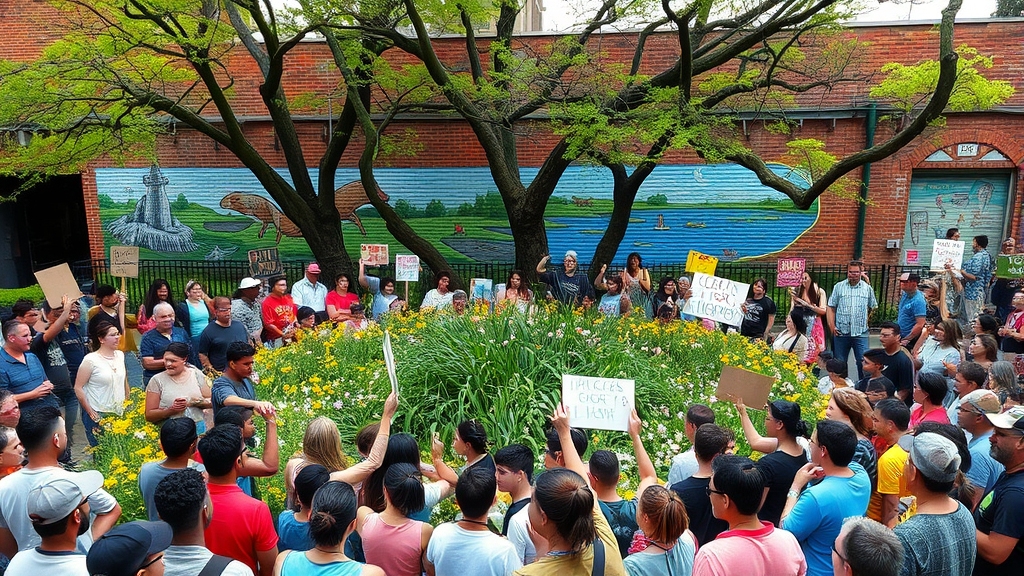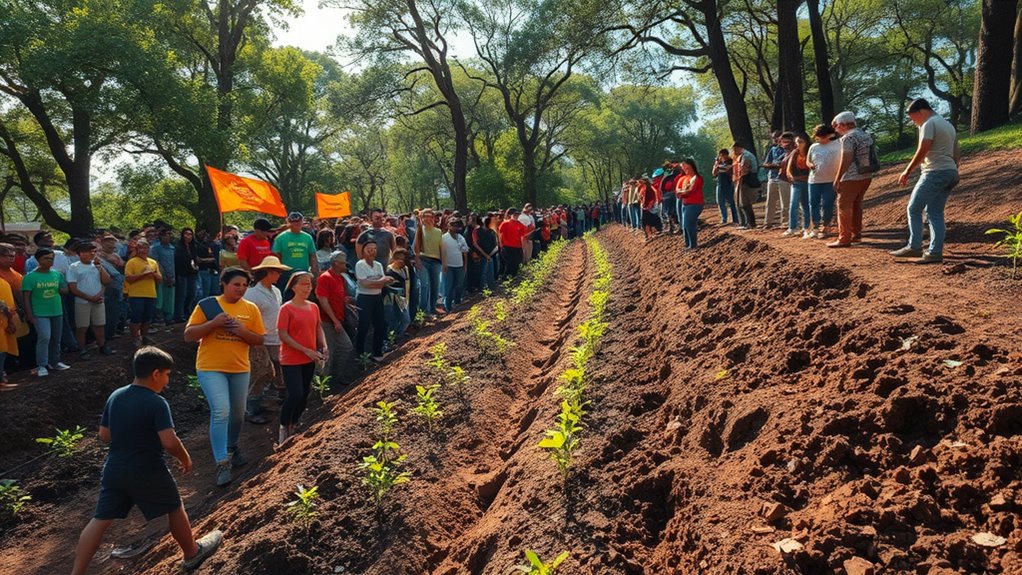Community-driven activism empowers you to make a real difference in protecting the environment. By participating in local initiatives, organizing clean-ups, and supporting sustainable policies, you help influence decision-makers and hold corporations accountable. Grassroots movements build trust and foster shared purpose among neighbors, creating lasting change. When communities come together, their collective voice becomes a powerful force for environmental preservation. Discover how your involvement can amplify impact and shape a healthier future.
Key Takeaways
- Local communities influence policies, promote sustainable practices, and hold corporations accountable through grassroots activism.
- Community mobilization and collective actions increase awareness and sway decision-makers to support environmental causes.
- Grassroots funding from local donors and small grants sustains initiatives and fosters a sense of ownership.
- Participation in activism strengthens community bonds and amplifies the movement’s impact through shared purpose.
- Collective efforts at the community level ensure long-term environmental protection for current and future generations.

Have you ever wondered how local communities can make a real difference in protecting the environment? It’s often through the power of local activism that change begins. When people come together with a shared concern, they can influence policies, hold corporations accountable, and promote sustainable practices. Grassroots movements are rooted in the idea that change starts at home, and they thrive when community members actively participate. Unlike large organizations that may feel distant or disconnected, grassroots efforts are personal and immediate, giving everyday people a voice in shaping their environment.
Local activism empowers communities to protect the environment and influence meaningful change.
One of the key strengths of grassroots environmental movements is their ability to mobilize local activism. You might see neighbors organizing clean-up events, advocacy campaigns, or educational workshops—each action building momentum for larger change. Local activism often involves rallying community members to speak out against harmful projects or policies that threaten local ecosystems. When residents stand together, they demonstrate to decision-makers that their concerns are genuine and urgent. This collective voice can sway public opinion and influence city councils, state agencies, or even national policymakers. Additionally, fostering community engagement can strengthen the sustainability of these initiatives by encouraging ongoing participation. Building trust within the community is essential for long-term success and continued collaboration.
Financial support plays a vital role in sustaining these efforts. Grassroots funding, which comes from community donations, local businesses, or small grants, keeps these initiatives alive. When residents invest in their environment, they show a real commitment to long-term change. Grassroots funding also empowers communities to run campaigns without relying solely on external organizations or government aid. It allows for more tailored, immediate responses to local issues, whether it’s restoring a park, fighting pollution, or protecting wildlife habitats. Funding at this level creates a sense of ownership and responsibility among community members, motivating them to stay involved.
Moreover, grassroots movements foster a sense of community and shared purpose. When you participate in local activism, you’re not just advocating for environmental protection—you’re building stronger bonds with your neighbors. These collective efforts often lead to increased awareness and education, inspiring others to get involved. As more people join, the movement gains strength, making it more difficult for harmful projects to move forward unnoticed. Additionally, integrating AI security technologies can enhance the protection of community-led initiatives by safeguarding their digital data and communications from cyber threats. Understanding how to leverage technology can further amplify the impact of grassroots efforts and help sustain them over time.
In the end, the power of community lies in its ability to harness local activism and grassroots funding to create meaningful change. It’s about people taking action where they live, showing that small, community-led efforts can have a big impact. When everyone pitches in—whether through volunteering, donating, or simply spreading awareness—you contribute to a collective force that safeguards the environment for current and future generations. Your involvement matters, and together, communities can drive the change they want to see in the world.
Frequently Asked Questions
How Do Grassroots Movements Secure Funding and Resources?
You can secure funding and resources for grassroots movements through effective fundraising campaigns, appealing directly to community members and supporters. Building strong volunteer networks helps mobilize local support and reduce costs. Additionally, you might seek grants from environmental organizations or partner with local businesses for sponsorships. Engaging your community and demonstrating impact encourages ongoing donations and resource sharing, ensuring your movement stays well-supported and sustainable.
What Legal Challenges Do Community Environmental Groups Face?
You might face legal hurdles and regulatory barriers when working on community environmental projects. These challenges can include complex permitting processes, zoning restrictions, or compliance requirements that delay or hinder your efforts. You need to stay informed about local laws and advocate for streamlined regulations. Building relationships with legal experts and community allies can help you navigate these obstacles and keep your movement moving forward effectively.
How Can Individuals Effectively Join or Start a Local Movement?
Imagine you want to start a local cleanup, like a community park project. To join or start a movement, focus on volunteer recruitment by reaching out through social media and local events. Raise public awareness by sharing stories and facts about the environmental issue. Engage neighbors and organizations to build momentum. Your proactive efforts can inspire others, making the movement stronger and more impactful.
What Are Successful Strategies for Sustaining Long-Term Engagement?
To sustain long-term engagement, focus on consistent volunteer recruitment and regular social media engagement. You should create clear goals that inspire members and keep them motivated. Use social media to share successes, updates, and calls to action, making involvement easy and rewarding. Foster a sense of community by recognizing contributions. Stay adaptable, listen to feedback, and celebrate milestones to maintain enthusiasm and commitment over time.
How Do Grassroots Efforts Influence National Environmental Policies?
Did you know that grassroots efforts have directly influenced over 60% of recent policy changes? You can see how community actions spark public awareness, putting pressure on policymakers to enact meaningful change. When you get involved, your voice helps shape national environmental policies, making them more responsive to local concerns. Your grassroots initiatives create momentum, encouraging policymakers to prioritize sustainable practices and enforce stronger environmental protections.
Conclusion
Now, as you see how grassroots movements ignite change, remember that your voice holds power. The community’s strength can challenge even the biggest corporations and policies. But the real question is—will you step up before it’s too late? The future of our environment depends on everyday people like you, risking everything for a cause greater than themselves. The movement is waiting, and your moment to make a difference might be closer than you think.








